Interview with Pat Henry FM Product Manager, Phonak Hearing Systems
Topic: Wireless Technologies
Beck: Hi Pat. Nice to speak with you again.
Henry: Hi. Doug. Thanks for asking me back.
Beck: Pat, for the readers that don't know you...you've been in the industry now for over 20 years, is that right?
Henry: Yes, that is right. I ran a couple of FM companies over the years before joining Phonak about 4 years ago to focus on product management of Phonak's line of FM products as well as new product development.
Beck: Pat, I'd like to focus in on wireless technologies today. I know Phonak offers a broad line of wireless instruments and technology, and so maybe the best place to start is with a working definition. What do you think of when you think about the term "wireless" as it relates to hearing technologies?
Henry: Today, we are experiencing a wireless revolution. We have a variety of electronic devices that connect us to our world --wireless telephones, wireless Internet. We believe today's advanced digital hearing aids should also be wireless-enabled, which improves the ability of hearing-impaired users to communicate with others when wearing these devices.
Wireless communication systems use radio waves to send and receive signals. This technology brings the speaker's voice directly to the listener over large distances. The result is that by eliminating interference from reverberation and background noise, communication becomes clear and comfortable. Ideal applications for these technologies include lectures, entertainment, telephone, social events as well as any remote listening need.
Beck: You mention a wireless-enabled communication system. What kind of system are you describing?
Henry: The new Phonak SmartLink combines a hearing aid remote control, FM transmitter and Blue Tooth compatibility.
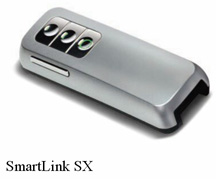
The remote control offers hands free access to all hearing aid functions and controls both right and left hearing aids together. Combining the remote control eliminates the need to carry multiple accessories.
The FM transmitter is equipped with three levels of directional microphones for control over different levels of background noise. The addition of Digital Fine Scale Noise Canceller offers even more control over environmental noise.
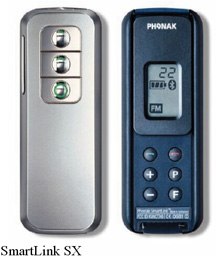
SmartLink also incorporates Blue Tooth technology. When combined with a Blue Tooth enabled cell phone, the patient has wireless, hands-free telephone communication. The signal is clear and free of distortion.

Beck: Great idea. In other words, now that we have Blue Tooth and similar wireless micro technologies, the limiting factor is not the hearing aid but more a matter of imagination and creativity.
Henry: Exactly. Today the main application is with Blue Tooth compatible cell phones. So if the cellular telephone rings, you answer the call with the SmartLink transmitter and talk on the phone through the SmartLink transmitter; the conversation is sent to the FM receivers attached to the personal behind the ear (BTE) hearing aids. The only time you need to touch the cellular telephone is to dial the number.
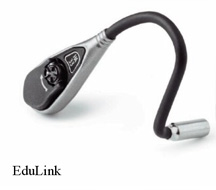
Beck: That is really neat. So rather than placing the cell phone up to your ear, you listen through your hearing aids and talk with the FM transmitter; The Blue Tooth cell phone is communicating wirelessly with the FM transmitter.
Henry: Right. Don't be surprised to see future TVs, MP3, CD and DVD players all utilize Blue Tooth technology. In turn, these "wireless enabled" devices would also interact with the SmartLink transmitter and FM receivers connected to the hearing aids.

Beck: So pretty soon we could see hearing instruments that offer true connectivity with entertainment systems, warning signals and cell phones.
Henry: Yes
Beck: What sort of time line are we looking at for these products?
Henry: Summer 2004 will be the release date for the SmartLink.
Beck: What else can we look forward to in the short term?
Henry: We're about to launch the "Universal Wireless CROS." hearing system, which as you know stands for the Contralateral Routing of Signal, used by people with unilateral hearing loss. For many years, only Telex had the wireless CROS technology, but Phonak purchased the CROS business about three years ago. Since that time, we took the best technology from the Phonak MicroLink System, and combined that with Telex's CROS technology, and we've created the "Universal Wireless CROS." In essence, it enables any MicroLink-compatible digital or analog BTE hearing aid to be used with a wireless CROS system. We feel that this represents a major advance in technology for patients with unilateral hearing loss.
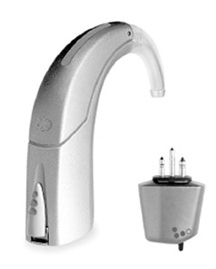
Beck: That sounds fabulous. Will you have BI-CROS capability for people with hearing loss on their better ear, and essentially a "non-serviceable" ear as their worse ear?
Henry: Yes. That'll be available with this technology, too. In fact, this will offer these patients the ultimate flexibility, in that they can simply add or remove the audioshoe and BiCROS receiver when they want, providing them with a state-of-the-art BiCROS or IROS system that is appropriate for every listening situation.
Beck: And I know most of us know, but for those who might need a reminder...the difference is that a CROS system has essentially one microphone on the worse side, and a BI-CROS system has two mics, one on each side. Regardless, with CROS or BI-CROS, the receiver is on the better ear! And IROS (ipsilateral routing of signal) is an analogy for monaural amplification.
Henry: Thanks, that's a good thing to note! I use this technology and these terms all the time, but I'm sure there are clinicians out there that rarely if ever think in these terms.
Beck: Are these available as BTEs and ITEs?
Henry: Currently, the transmitter is a BTE design; the receivers offer a choice of ITE or BTE designs. As stated, the BTE system is a "universal" system, in that it may be used with any MicroLink-compatible hearing aid. The ITE system is a state-of-the-art hearing aid. It is important to note that these systems are also compatible with MicroLink FM systems by adding an FM receiver to the off-side transmitter.
Beck: What about wireless technology and cochlear implants and other devices besides hearing aids?
Henry: Phonak works closely with all three major cochlear implant manufacturers to make sure these technologies are available for cochlear implant users as well. We know that cochlear implant wearers benefit from improved signal to noise ratio provided by FM. All CI processors are now compatible with Phonak FM systems. Cochlear was the first CI manufacturer to come out with an ear level cochlear implant processor. Combining FM to the ear level processor eliminates cables and wires historically used with body worn processors. We also have systems that are compatible with the BAHA bone conduction system.
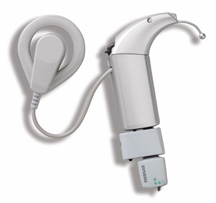
We are also introducing two new products to the market this fall including MicroField, which we can talk about in the next interview. And EduLink, a new product for children with Auditory Processing Disorders, minimal or unilateral hearing loss or for anyone needing a better signal to noise ratio. It's not a hearing aid. It's an FM device to improve the signal quality and make it easier for children to hear above the noise in the classroom.
Beck: Pat these are simply amazing strides. Thanks for taking the time to bring me up-to-date on these advances. Is there a web-site that features wireless and FM products?
Henry: My pleasure Doug. Consumers and professionals can learn more about these topics at www.phonak.com.
- - - - -
View SmartLink Brochure
View EduLink Brochure
Henry: Hi. Doug. Thanks for asking me back.
Beck: Pat, for the readers that don't know you...you've been in the industry now for over 20 years, is that right?
Henry: Yes, that is right. I ran a couple of FM companies over the years before joining Phonak about 4 years ago to focus on product management of Phonak's line of FM products as well as new product development.
Beck: Pat, I'd like to focus in on wireless technologies today. I know Phonak offers a broad line of wireless instruments and technology, and so maybe the best place to start is with a working definition. What do you think of when you think about the term "wireless" as it relates to hearing technologies?
Henry: Today, we are experiencing a wireless revolution. We have a variety of electronic devices that connect us to our world --wireless telephones, wireless Internet. We believe today's advanced digital hearing aids should also be wireless-enabled, which improves the ability of hearing-impaired users to communicate with others when wearing these devices.
Wireless communication systems use radio waves to send and receive signals. This technology brings the speaker's voice directly to the listener over large distances. The result is that by eliminating interference from reverberation and background noise, communication becomes clear and comfortable. Ideal applications for these technologies include lectures, entertainment, telephone, social events as well as any remote listening need.
Beck: You mention a wireless-enabled communication system. What kind of system are you describing?
Henry: The new Phonak SmartLink combines a hearing aid remote control, FM transmitter and Blue Tooth compatibility.

The remote control offers hands free access to all hearing aid functions and controls both right and left hearing aids together. Combining the remote control eliminates the need to carry multiple accessories.
The FM transmitter is equipped with three levels of directional microphones for control over different levels of background noise. The addition of Digital Fine Scale Noise Canceller offers even more control over environmental noise.

SmartLink also incorporates Blue Tooth technology. When combined with a Blue Tooth enabled cell phone, the patient has wireless, hands-free telephone communication. The signal is clear and free of distortion.

Beck: Great idea. In other words, now that we have Blue Tooth and similar wireless micro technologies, the limiting factor is not the hearing aid but more a matter of imagination and creativity.
Henry: Exactly. Today the main application is with Blue Tooth compatible cell phones. So if the cellular telephone rings, you answer the call with the SmartLink transmitter and talk on the phone through the SmartLink transmitter; the conversation is sent to the FM receivers attached to the personal behind the ear (BTE) hearing aids. The only time you need to touch the cellular telephone is to dial the number.

Beck: That is really neat. So rather than placing the cell phone up to your ear, you listen through your hearing aids and talk with the FM transmitter; The Blue Tooth cell phone is communicating wirelessly with the FM transmitter.
Henry: Right. Don't be surprised to see future TVs, MP3, CD and DVD players all utilize Blue Tooth technology. In turn, these "wireless enabled" devices would also interact with the SmartLink transmitter and FM receivers connected to the hearing aids.

Beck: So pretty soon we could see hearing instruments that offer true connectivity with entertainment systems, warning signals and cell phones.
Henry: Yes
Beck: What sort of time line are we looking at for these products?
Henry: Summer 2004 will be the release date for the SmartLink.
Beck: What else can we look forward to in the short term?
Henry: We're about to launch the "Universal Wireless CROS." hearing system, which as you know stands for the Contralateral Routing of Signal, used by people with unilateral hearing loss. For many years, only Telex had the wireless CROS technology, but Phonak purchased the CROS business about three years ago. Since that time, we took the best technology from the Phonak MicroLink System, and combined that with Telex's CROS technology, and we've created the "Universal Wireless CROS." In essence, it enables any MicroLink-compatible digital or analog BTE hearing aid to be used with a wireless CROS system. We feel that this represents a major advance in technology for patients with unilateral hearing loss.

Beck: That sounds fabulous. Will you have BI-CROS capability for people with hearing loss on their better ear, and essentially a "non-serviceable" ear as their worse ear?
Henry: Yes. That'll be available with this technology, too. In fact, this will offer these patients the ultimate flexibility, in that they can simply add or remove the audioshoe and BiCROS receiver when they want, providing them with a state-of-the-art BiCROS or IROS system that is appropriate for every listening situation.
Beck: And I know most of us know, but for those who might need a reminder...the difference is that a CROS system has essentially one microphone on the worse side, and a BI-CROS system has two mics, one on each side. Regardless, with CROS or BI-CROS, the receiver is on the better ear! And IROS (ipsilateral routing of signal) is an analogy for monaural amplification.
Henry: Thanks, that's a good thing to note! I use this technology and these terms all the time, but I'm sure there are clinicians out there that rarely if ever think in these terms.
Beck: Are these available as BTEs and ITEs?
Henry: Currently, the transmitter is a BTE design; the receivers offer a choice of ITE or BTE designs. As stated, the BTE system is a "universal" system, in that it may be used with any MicroLink-compatible hearing aid. The ITE system is a state-of-the-art hearing aid. It is important to note that these systems are also compatible with MicroLink FM systems by adding an FM receiver to the off-side transmitter.
Beck: What about wireless technology and cochlear implants and other devices besides hearing aids?
Henry: Phonak works closely with all three major cochlear implant manufacturers to make sure these technologies are available for cochlear implant users as well. We know that cochlear implant wearers benefit from improved signal to noise ratio provided by FM. All CI processors are now compatible with Phonak FM systems. Cochlear was the first CI manufacturer to come out with an ear level cochlear implant processor. Combining FM to the ear level processor eliminates cables and wires historically used with body worn processors. We also have systems that are compatible with the BAHA bone conduction system.

We are also introducing two new products to the market this fall including MicroField, which we can talk about in the next interview. And EduLink, a new product for children with Auditory Processing Disorders, minimal or unilateral hearing loss or for anyone needing a better signal to noise ratio. It's not a hearing aid. It's an FM device to improve the signal quality and make it easier for children to hear above the noise in the classroom.
Beck: Pat these are simply amazing strides. Thanks for taking the time to bring me up-to-date on these advances. Is there a web-site that features wireless and FM products?
Henry: My pleasure Doug. Consumers and professionals can learn more about these topics at www.phonak.com.
- - - - -
View SmartLink Brochure
View EduLink Brochure

